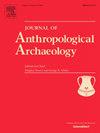“Weaving” the tupi: The study of kʷaẽ language and the persistence of pottery-making knowledge among the Akuntsu women, southwestern Amazon
IF 2.2
1区 社会学
Q1 ANTHROPOLOGY
引用次数: 0
Abstract
Grounded in the archaeology of persistence, decolonial perspectives, and technological approaches to ceramic manufacture, this study examines pottery-making as both a material expression of resilience and a site of ongoing identity negotiation. Integrating notions of intersubjectivity and intercorporeality, this paper explores the interrelation between technical processes, embodied knowledge, and territorial experiences. Focusing on the persistence of pottery-making knowledge among Akuntsu women (Tupi, Tupari), the study highlights its ties to cosmology. The Akuntsu, a recently-contacted Indigenous people, faced genocidal attacks as their ancestral territory in the Rondônia State, Brazil, was violated. Today, only three Akuntsu women—Pugapia, Aiga, and Babawro—remain as survivors of this group. To understand the chaîne opératoire of pottery production among Akuntsu women, this research promotes interdisciplinary dialogue, recognizing the fusion of knowledge with territorial, language, and material experiences from an ethnoarchaeological perspective. We explore the interplay between women featured in historical narratives, fermented beverage, saliva, tupi (clay), and pottery-making process as carriers of subjectivity and potentiality. The findings reveal that the chaîne opératoire of production of kʷaẽ (clay pots) endures as a cultural practice despite historical disruption from contact-related violence. The persistence of the three Akuntsu women in tupi shaping exemplifies the resilience of their traditions and illustrates how Indigenous material practices engage with broader debates on persistence, coloniality, and the interconnections between bodies, artifacts, and territories.
“编织”图皮:亚马孙西南部Akuntsu妇女对k -阿卡语的研究和对制陶知识的坚持
本研究立足于陶瓷制造的持久性考古学、非殖民化视角和技术方法,将陶器制作作为一种韧性的材料表达和一种正在进行的身份协商的场所进行研究。本文结合主体间性和肉体间性的概念,探讨技术过程、具身知识和地域经验之间的相互关系。研究聚焦于Akuntsu女性(图皮人,图帕里人)持续的制陶知识,强调了其与宇宙学的联系。Akuntsu人是最近接触的土著人民,由于其祖先在巴西Rondônia州的领土受到侵犯,他们面临种族灭绝攻击。今天,只有三个Akuntsu女性- pugapia, Aiga和babawro -仍然是这个群体的幸存者。为了了解Akuntsu妇女陶器生产的cha ne opsamatoire,本研究促进跨学科对话,从民族考古学的角度认识到知识与领土、语言和物质经验的融合。我们探索历史叙事中的女性、发酵饮料、唾液、陶土和制陶过程之间的相互作用,作为主体性和潜在性的载体。研究结果表明,尽管与接触有关的暴力在历史上造成了破坏,但生产k k a a a(陶罐)的cha ne opsamatoire作为一种文化习俗仍然存在。三位Akuntsu女性对tupi造型的坚持体现了她们传统的韧性,并说明了土著材料实践如何与持久性,殖民性以及身体,文物和领土之间的相互联系进行更广泛的辩论。
本文章由计算机程序翻译,如有差异,请以英文原文为准。
求助全文
约1分钟内获得全文
求助全文
来源期刊

Journal of Anthropological Archaeology
Multiple-
CiteScore
4.00
自引率
11.10%
发文量
64
期刊介绍:
An innovative, international publication, the Journal of Anthropological Archaeology is devoted to the development of theory and, in a broad sense, methodology for the systematic and rigorous understanding of the organization, operation, and evolution of human societies. The discipline served by the journal is characterized by its goals and approach, not by geographical or temporal bounds. The data utilized or treated range from the earliest archaeological evidence for the emergence of human culture to historically documented societies and the contemporary observations of the ethnographer, ethnoarchaeologist, sociologist, or geographer. These subjects appear in the journal as examples of cultural organization, operation, and evolution, not as specific historical phenomena.
 求助内容:
求助内容: 应助结果提醒方式:
应助结果提醒方式:


